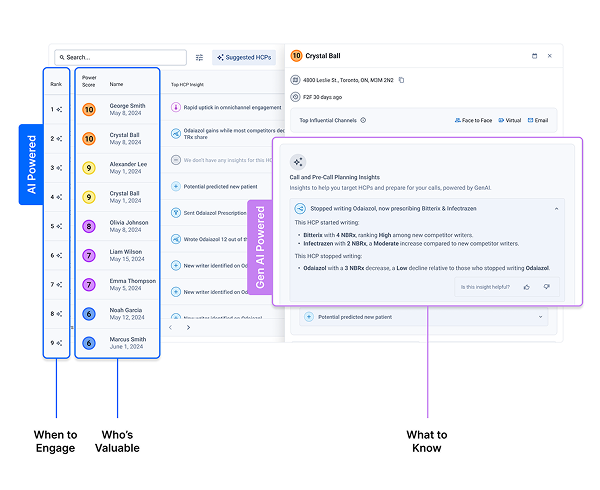Why Pharma Needs to Rethink Targeting
For decades, the playbook for segmentation and targeting has barely changed. Commercial teams ranked healthcare providers by past prescription volume, slotted them into deciles, and handed the top tiers to the field. The year’s call plan and resource allocation were built on that static foundation.
It worked — sort of. It wasn’t predictable, nor easy to repeat, and produced generic, syndicated insights for the entire market that offered minimal competitive advantage. The data was also stale the moment it arrived and had downstream implications across many aspects of commercial execution, from marketing campaigns to reps’ face-to-face interactions with HCPs and digital engagement across sites and portals.
By the time a list made it through analysis, approval, and rollout, real life had moved on. Doctors retired, switched specialties, or shifted their prescribing. Competitors launched new products. Coverage changed. And none of it showed up until the next annual or semiannual refresh.
Real-time data is everywhere, and static targeting isn’t keeping up. It’s not just inefficient, but actively slows down your ability to adapt. That’s where dynamic targeting can rewrite the script, figuratively and literally.
The Problem with Traditional HCP Targeting
The traditional static targeting model is straightforward and hasn’t changed much for a few decades:
- Rank physicians by market based on their historic prescription volume (market decile).
- Twice a year, tier them into groups (for example, the top 10%, middle 30%, bottom 60%).
- Create sales and marketing resource plans based on tier.
- Target the HCPs on the list every quarter based on their grouping.
Some add other layers to the data, like product-specific volume, market volumes, or payer mix. But at its core, it’s still backward-looking and volume-driven data. And the problems stack up fast.

Common Pitfalls of Decile-Based Approaches
Lists are outdated before they’re used, because segmentation is performed on a few times a year while targeting happens quarterly. All top-decile HCPs get the same treatment, whether they’re writing your brand or not.
Reps have little or no flexibility for behavioral nuance, like promotional responsiveness, engagement with digital campaigns, or local competitive shifts. Most importantly, there’s no context explaining why an HCP should be a priority now.
In Sharon’s experience, it’s not uncommon for reps to receive calls lists that include call on doctors who have after they’ve stopped practicing.
What is Dynamic Targeting?
Dynamic segmentation and targeting is an AI-powered approach to prioritizing HCPs based on multiple real-time data points, not just prescription volume from the last quarter.
The model:
- Runs continuously in the background
- Prioritizes HCPs based on multiple real-time signals (more on these below)
- Adjusts quickly to market changes, not just historical trends
At its core, dynamic targeting answers four critical questions that are top of mind for pharma reps every day:
- Who matters most right now?
- When is the best time to call on them?
- How often should I be in contact?
- What message is likely to resonate with them?
The signals can be obvious or subtle. There may be a spike in category prescriptions or a visit to your brand’s website. The goal is to catch relevant signals when they happen, not months later.

Data Signals Used in Dynamic Targeting
The system pulls from a wide mix of data: market and product deciles, changes in payer coverage, how prescribing shifts after a rep visit or other promotion, even patterns in reimbursement.
It also watches for digital cues like visits to your website, clicks on ads, and content downloads, all signals that an HCP is trying to learn more.
Blend these signals together, and you get a dynamic score that predicts a physician's current relevancey to your brand and potential near-term opportunities.

How Dynamic Targeting Works in Practice
With ODAIA’s platform, dynamic targeting is driven by connected AI engines. One measures potential value. Another picks up signals of current interest or need. A third distills that data into context that a rep can act on. Together, they refresh priorities weekly—or faster—at the individual territory level.
The difference is immediate: National averages are no longer applied to every territory. Priorities can shift with market realities. Every HCP targeting recommendation comes with a clear rationale and guidance on how best to approach them.
For the field, this shortens pre-call planning and sharpens focus. Instead of wading through a static list, reps start the week knowing exactly where to spend their time—and why.

What Success Looks Like with Dynamic Targeting
Teams that adopt dynamic targeting see gains in both metrics and morale. As Frank, Sharon, and Pete have all seen, the early gains are hard to miss:
- New opportunities: Teams discover relevant HCPs that static models miss.
- Smarter, dynamic call frequencies: High-value HCPs get the right number of visits based on how they respond.
- Better timing: Sales reps schedule visits around prescribing cycles or engagement spikes.
- Stronger engagements: HCP-level insights guide not just when to call, but what to say — making conversations more relevant and effective.
- More time selling: Sales teams spend fewer hours analyzing data and more time with HCPs.
For more examples on how dynamic targeting is transforming commercial pharma , browse our customer showcase.
Making the Shift: Steps to Get Started
Switching to dynamic targeting is as much about change management and bringing people along as it is about a tech upgrade. Six key steps make the difference.
1) Prep Your Organization for Change: Start with the “why.” Reps need to clearly understand how dynamic targeting helps them reach the right doctors with the right patients, not just that they’re getting a new list.
2) Build Buy-In Across Teams: Early adopters can make or break the rollout.Include top performers in early pilot projects. They can get teams believing in a new approach better than any slide deck.
3) Focus on Implementation & Adoption: Leaders play a critical role in reinforcing new behaviors. Managers need support, coaching, and tools so they can translate the data into daily action with their teams.
4) Measuring & Iterating for Success: Success with dynamic targeting requires a new measurement mindset. Old metrics designed for static models don’t capture the speed and fluidity of this approach. Weekly results and real-time dashboards replace the lag of quarterly reporting, ensuring reps act before opportunities close.
5) Create feedback loops: Dynamic targeting isn’t set-and-forget. Regular check-ins with reps and managers reveal what’s resonating in the field and what needs adjustment. Feedback also ensures the system keeps learning, improving accuracy and trust over time.
6) Commit fully: Half measures cause confusion. If leadership relies on static reporting while the field is guided by dynamic targeting, teams get mixed signals and adoption stalls. Clear alignment and commitment at every level are essential.

If exploring more practical examples and insights on AI adoption is of interest, our recent webinar, AI in Action Today showcases proven strategies from industry leaders navigating this shift.
Looking Ahead: Dynamic Targeting as the Foundation for Omnichannel Pharma
Dynamic targeting isn’t a destination. It’s the foundation for a smarter, more flexible, and responsive commercial strategy. Once real-time targeting is in place:
- Omnichannel orchestration can become truly personal.
- Brand messaging can be adjusted in days, not months.
- Every interaction with an HCP, whether digital or in-person, feeds right back into the model.
With dynamic targeting as the foundation, brand and marketing teams can start connecting campaigns to real business results—aligning with field efforts for more personalized, coordinated engagements. Discover how Campaign Intelligence supports omnichannel engagement.
The Road to Ongoing Agility & Commercial Effectiveness
Static targeting belongs to an era when the market moved slower and the availability of data was sparse. Today, when data is plentiful, it’s agility that wins.
Dynamic targeting puts reps in front of the right HCPs, at the right time, with the right story, and backs every call with evidence instead of instinct. It shrinks the gap between market change and field action from months to days. The teams that make the shift aren’t just keeping up. They’re getting ahead.
For teams interested in taking a practical next step, ODAIA's Opportunity Analysis offers a clear path forward.
It’s a useful process to build internal alignment, evaluate commercial impact, and generate momentum for change—making it easier to see where dynamic targeting can move the needle for your business.







